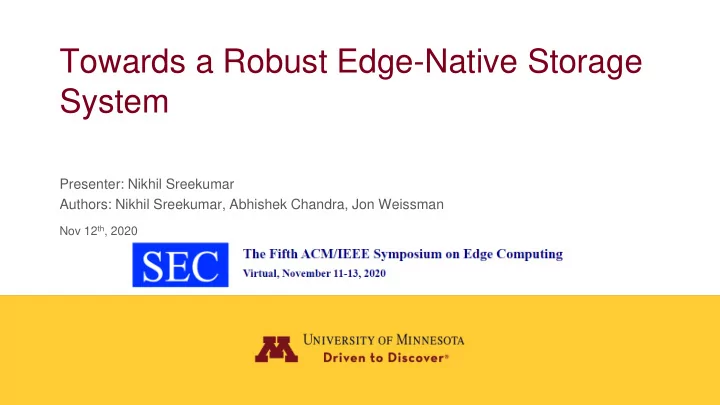

Towards a Robust Edge-Native Storage System Presenter: Nikhil Sreekumar Authors: Nikhil Sreekumar, Abhishek Chandra, Jon Weissman Nov 12 th , 2020
Let’s go to a State Fair
Cloud solution Latency Bandwidth Cost Cloud Privacy Data Limitations This is where edge storage comes…
Existing Edge solutions Physical transfer Direct sync Cloud Edge storage nodes – temporary compute and storage Limitations Privacy of Low latency Mobility Data management data data sharing
Vision An edge-native storage system that can operate anywhere with minimal infrastructure requirements by utilizing both pre-deployed and volatile/voluntary resources, catered to the needs of edge applications.
Challenges Heterogeneity and churn Data migration, replication, consistency Privacy/security Storage Dedicated Volunteer Dedicated resources resources Mobile user/device Volatile/Volunteer Data retention and discard Evict data Retention time Bandwidth variation
Can Cloud data management/storage solution be used at the Edge? Decentralized, distributed, NoSQL database High availability, performance and scalability What makes Cassandra edge friendly? Local store Decentralized & Distributed Scalable and Flexible Fast writes Hinted handoff/ Fault tolerance
Cassandra limitations - Constrained network bandwidth YCSB Workload: ➢ Workloads A(50-50 read-write), B (95-5 read-write), C (100 read) and D (95-5 read-insert) - 10000 ops Inference ➢ Fails to perform in low bandwidth situations
Cassandra limitations – Data placement and replication Data placement and replication Consistent hashing used to identify location of data storage But for Edge… App requirements User mobility Node capacity Node volatility Bandwidth & Latency Decides data placement and replication strategy
Design Principles Dependent on • Application requirements • Existing cloud principles • QoS • User behavior
QoS-driven storage location/tier selection Persistent store backup Storage install location Volatile tier Erasure Dynamic selection of tiers coding
Context/mobility aware data placement App requirements Node capacity Prediction of next edge Storage node selection server region Node volatility Bandwidth & Latency
Dynamic replication and hinted handoffs Local store Region 2 Region 1 Change the replica count to adapt with Hinted handoff for resource limitation fault tolerance in high Consistency policies changes churn environment dynamically
Managed privacy Trust management Use edge storage to Denature data before with volunteer store private data sending to cloud resources Encryption, Filter private data differential privacy Obfuscation, secure aggregation in ML
Conclusion Challenges Cloud storage App Scenario tool at the Edge? Design Principles We believe a future edge storage system must be decentralized, QoS-driven, user/mobility aware and dynamic
Nikhil Sreekumar Abhishek Chandra Jon Weissman sreek012@umn.edu chandra@umn.edu jon@cs.umn.edu NSF Grants: CNS-1908566 and CNS-1619254 Distributed Computing Systems Group University of Minnesota
Recommend
More recommend